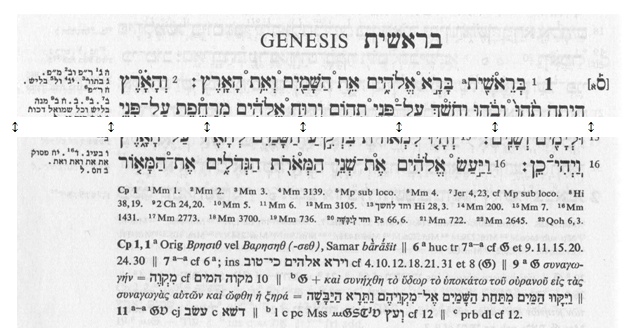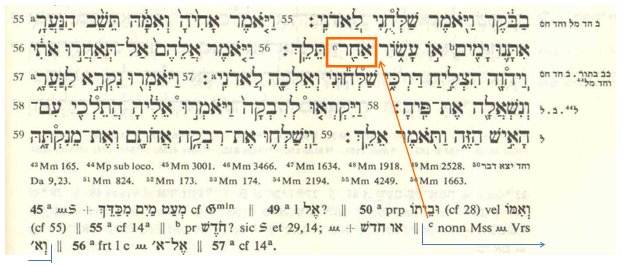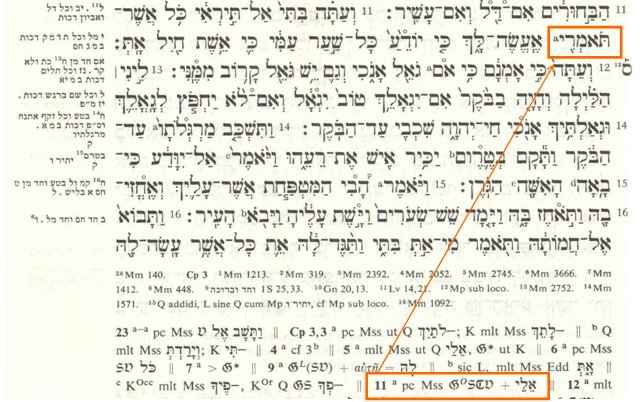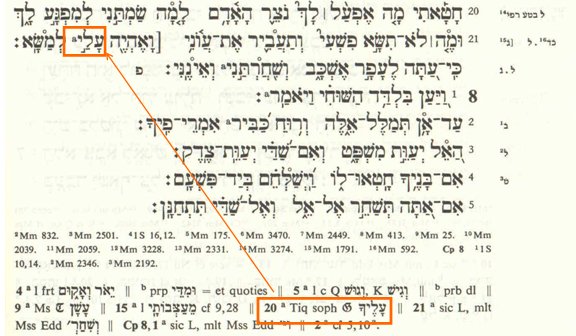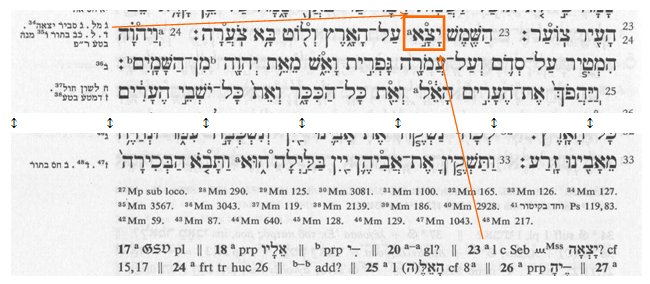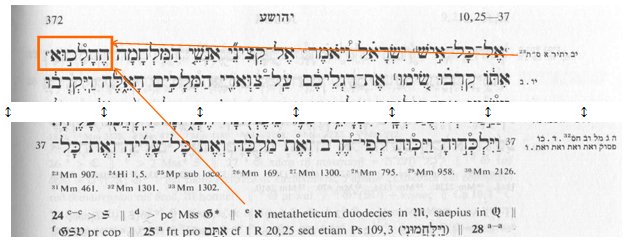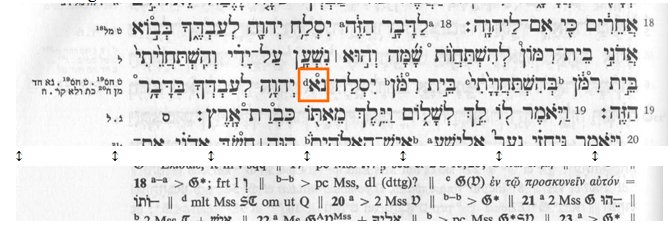STEPBible - Scripture Tools for Every Person - from Tyndale House, Cambridge
__
More about OT Scribal editing
Scribal Notations in the Masoretic Text
by Charles L. Echols, Ph.D.[1]
When opening the Hebrew Bible to any page, the eye is struck with a tremendous amount of information. Most prominent is the text where, apart from the pointing, one sees various phenomena including small circles over letters and, occasionally, letters that are larger than the others. The side margin of the page has further notations, and the bottom has two sets of information. This document is intended to provide an overview of some of the main types of paratextual notations that were supplied by the Masoretes.
The Hebrew Text that most of us read—the text that is printed in Biblia Hebraica Stuttgartensia (BHS)—is a complex product by many hands through several eras. (See more on the history of Hebrew Bible editions here)
No one knows whether the final form of the Old Testament was originally one text or whether there were regional texts (e.g., Alexandrian, Babylonian, Palestinian). What is known is that it was originally written using only consonants. Beginning in about the 7th c. BC, certain consonants were used to represent vowels (e.g.,ה ,ו , י), but at that stage such “vowels” were added only to the end of words (i.e. “terminal” vowels). In time such vowels were added to the middle of words (i.e. “medial” vowels). Around the turn of the millennium, different groups of Jewish scholars added different systems of diacritical marks to the consonantal text to represent all of the vowels. (Adding vowels to the consonants is called “pointing” the text.) The Tiberian system, for example, pointed the text below the consonants (e.g., בִ), while the Babylonian system pointed above the consonants (e.g., ב֓).
The term “Masoretes” refers to a group of Jewish scholars who copied and transmitted the Hebrew text from ca. AD 800-AD 1000. There were different families of Masoretes, but the most important for the modern Hebrew text is the ben Asher family which produced a number of codices, e.g., Cairensis, Aleppo, and Leningradensis (the last being the basis for the text of BHS). The name Masoretic Text (MT, or ) also reflects the addition of notations (the Masora) by the Masoretes to the text, particularly those in the margins and on the bottom of the page.[2] The term “Masoretic Text” is sometimes used in ways that are ambiguous. Tov provides a helpful clarification:
The various components of the text were inserted by different people. Soferim, “Scribes” wrote down the consonantal text, naqdanim, “vocalization experts” added the vowels and accents, and Masoretes (ba‘alê ha-Masorah, “masters of the Masorah”) wrote the notes of the Masorah. However, the Masoretes were often also involved with the other components of and, therefore, the term Masoretes often refers to those involved with all aspects of the copying of the medieval manuscripts.[3]
Masora
As assiduous students, the Masoretes took meticulous, detailed notes on the text that they received. The notes occur in the margins of each page and at the end of each book of the Old Testament. Masora Parva (Mp) refers to the notes on the side margin of the page. Masora Magna (Mm) refers to the notes near the bottom of the page between the last line of Scripture and the beginning of the critical apparatus of BHS. The Mm are not included in BHS, but are published separately as the Massorah Gedolah (Mg). Masora Finalis is sometimes used to refer to the notes at the ends of the books, but it is properly reserved for the alphabetical lists compiled by ben Chayyim from the Mg for his edition of the MT (see more here).
On the right is an example of the Mp and Mm from Gen 1:1. Notice the small circles above several of the words. These circles direct you to the Mp. When the Masoretes wanted to register a note about a single word, they placed a small circle over the center of the word (e.g., see בְּרֵאשִׁית, Gen 1:1). For a phrase they placed a small circle above and between each of the words of the phrase (e.g., see בָּרָא אֱלֹהִים, Gen 1:1). The circles direct the reader to the Mp. If a line has multiple circles, the reader looks to the corresponding number in the Mp. To use the Mm, one works from the Mp. If a circle over a word in the text has a number in the Mp, that number has a corresponding number in the Mm. For example, the circle over בְּרֵאשִׁית takes you to the Mp, where the Masoretes have noted that the word occurs five times: three times at the beginning of the verse, and twice in the middle. The superimposed “1” and “2” direct you to the Mm near the bottom of the page where you see: “1Mm 1” and 2Mm2.” These notations correspond with the lists in the Masorah Gedolah that specify the respective three and two verses.
Ketiv-Qere
Many times the Scribes wanted to indicate that the oral reading (the Qere) should be different to the actual written text (the Ketiv). Sometimes the written text had an archaic form of Hebrew, or an obvious error, or a phrase which was indecorous or potentially heretical. The Scribes were determined not to change the text itself, so they wrote the alternative form in the margin. (See more here)
Petuḥah (פ)
In the early days, manuscripts distinguished between open and closed paragraphs—a distinction that was lost by the time of the Masoretes. The sign פ is short for פְּתוּחָא, “open,” and as the word suggests, it denotes an open paragraph, i.e. a paragraph that begins on a new line.
Setuma (ס)
The sign ס is short for סְתוּמָא, “closed,” and indicates a closed paragraph. Such paragraphs continued on the same line as the preceding paragraph and were separated by a short space. Since the practice of distinguishing open and closed paragraphs was so inconsistent, the Masoretes omitted the signs פ and ס. They were added to BHS by the editors.
Seder (ס֡, סֵדֶר)
The sign ס֡ is short for סֵדֶר, meaning “order” or “sequence.” It is from the Palestinian tradition which divides the Old Testament (OT) into 452 readings and the Pentateuch into 168 readings so that the OT would be read in its entirety over three years. The sign predates the division of the Bible into chapters by Archbishop Stephen Langton (*1150-1228*) and into verses beginning in the Talmudic period, subsequently by Rabbi Isaac Nathan ben Kalonymus (ca. 1448), and still later by others.[4] The number of sedarim varies somewhat from manuscript to manuscript. The sign is placed on the inside margin in BHS and marks the beginning of the reading. Note that the accent on the top of the letter distinguishes it from the setûmā’.
Parashah (פרשׁ)
The sign פרשׁ is from the Babylonian tradition and divides the Pentateuch into 53 or 54 weekly readings that cover the Pentateuch in one year. The sign is placed on the inside margin in BHS and marks the beginning of the reading. For an example of the concurrence of ס֡ and פרשׁ, see Numbers 33:1.
Itture Sopherim
This term translates as “scribal omissions,” and as the name suggests marks omissions from the text. The Babylonian Talmud (Ned. 37b) states that there are approximately seventeen itture sopherim.
On the right is an example from Gen 24:55.
The word in the box is the adverb “after.” Originally it was prefaced by the wāw conjunction, i.e. “and after,” but the scribes omitted it from the text. BHS does not register itture sopherim in the Mp. The example in Gen 24:55 is noted in the critical apparatus (underlined), where the editor states that a number of Hebrew manuscripts (nonn Mss), the Samaritan Pentateuch (), and the versions (Vrs) read with the original text that had the conjunction.
The itture sopherim also include words which are to be read even though they are absent from the text.
On the right is an example from Ruth 3:11.
The verse translates, “And now, my daughter, do not fear; for all that you say I will do…” The scribes recognized that the verb should have the indirect object “to me,” and so added אֵלַי to the list of words to be added to the text. The addition is reflected in the critical apparatus where the phrase “to me” appears in a few Hebrew manuscripts, Origen’s recension of the Septuagint, the Syriac, Targums, and Vulgate.
Tiqqune Sopherim
The term means “scribal corrections,” and refers to scribal emendation of the text for reasons of propriety, theology, and so forth. Tov notes that these corrections are absent from “early sources” and “medieval manuscripts,” and appear “only in the apparatus of the Masora.”[5] The exact number of tiqqune sopherim is uncertain. Würthwein mentions a Masoretic tradition that registered 18 (Gen 18:22; Num 11:15; 12:12; 1 Sam 3:13; 2 Sam 16:12; 20:1; 1 Kgs 12:16; 2 Chr 10:16; Jer 2:11; Ezek 8:17; Hos 4:7; Hab 1:12; Zech 2:12; Mal 1:13; Ps 106:20; Job 7:20; 32:3; Lam 3:20), but cautions that some scholars record as few as three (1 Sam 3:13; Zech 2:12; Job 7:20), regarding the other fifteen as “midrashic interpretation.”[6]
Since Job 7:20 occurs in both lists, it is a good example - it on the right:
Interestingly, the ESV translates the text as it was received by the Masoretes, while the NASB translates with the tiqqune sopherim (the Masorete’s correction). The difference is in italics:
- ESV “If I sin, what do I do to you . . . Why have I become a burden to you?
- NASB “Have I sinned? What have I done to you . . . so that I am a burden to myself?”
Evidently the scribes regarded the possibility that Job could burden God to be theologically problematic and/or offensive. So they changed the text so that Job burdens himself.
BHS notes tiqqune sopherim with superscripted letters—here “a”—that direct the reader to the critical apparatus. In v. 20, the superimposed a in the critical apparatus alerts us to the tiqqune sopherim (Tiq soph) and tells us that the Septuagint ( ) reads with the original text, i.e. עָלֶיךָ.
Sebirin
In many instances, the Masoretes observed a word that was liable to be misconstrued. Estimates vary on the number of such words. Tov, for example, gives a range of between 70-200, while Würthwein refers to Christian D. Ginsburg, who put the number at 350.[7] The reason for the large discrepancy is unclear. Ginsburg’s total is from a comparison of many different manuscripts, so it could be that a given sebir occurs in one but not another. The subjective judgment over which words were deemed to be ambiguous is surely a factor. In any case, the Masoretes were concerned that readers would suppose that the word was in need of correction. They referred to such words as sebirin, from the Aramaic “to suppose” or “think” (סביר), and made marginal notes to warn readers against emending the text.
On the right is an example from Gen 19:23.
The critical apparatus (23a) states: “read (l) with (c) the sebir (Seb), several Samaritan Pentateuch manuscripts (Mss) יָצְאָה?, compare (cf) Gen 15:17. The issue is whether √יצא should be inflected as masculine or feminine. has the masculine inflection. The sebir has the feminine form and is proposed by the editor based on the indicated variants, but also because in Gen 15:17 the same subject, הַשֶּׁמֶשׁ, takes a feminine verb (בָּאָה). שֶּׁמֶשׁ, however, is a noun that is both masculine and feminine. Hence, the Masoretes registered the sebir to alert readers against emending √יצא to the third feminine singular, but the textual apparatus indicates that the editor and variants thought otherwise.
Yathir Letters
According to Tov, in some Masorah manuscripts a Qere is occasionally used to designate a yathir, or “superfluous,” letter that the reader should ignore.[8]
On the right is an example from Josh 10:24.
The ’ālep of הֶהָלְכוּא is problematic to say the least and should be ignored. The editor thinks evidently that it reflects a metathesis, but the more likely explanation is dittography since the following word also begins with ’ālep.
Okhlah weOkhlah
The Okklah weOkhlah is a list of words that occur only twice—once with and once without the wāw conjunction. The name of the list derives from the first pair, אָכְלָה (1 Sam 1:9) and וְאָכְלָה (Gen 27:19).
Nedarim 37b-38a
Although technically not Kethib-Qeres, there are other Masoretic notations that function similarly. The Babylonian Talmud tractate Nedarim 37b-38a mentions a list of words that are not in the text but that the scribes thought should be, and a list of words that are in the text that the scribes thought should not be (cf. the itture sopherim).
1. The following is the list of words to be added (indicated in brackets):[9]
- 2 Sam 8:3 (on the right)
David also defeated Hadadezer the son of Rehob, king of Zobah, as he went to restore his power at the river [Euphrates].
In the boxed area, the Masoretes have supplied the vowel points for the noun “Euphrates” (cf., e.g., Gen 2:14). The small circle above the vowel points directs you to the Mp, where the consonants are written. The superimposed “c” just after בִּנְהַר־ directs you to the critical apparatus, where the editor notes that many Hebrew manuscripts have “Euphrates” and invites a comparison with the versions. The Septuagint and Vulgate, for example, also have “Euphrates.”
- 2 Sam 16:23
וַעֲצַת אֲחִיתֹפֶל אֲשֶׁר יָעַץ בַּיָּמִים הָהֵם כַּאֲשֶׁר יִשְׁאַל־ בִּדְבַר הָאֱלֹהִים כֵּן כָּל־עֲצַת אֲחִיתֹפֶל גַּם־לְדָוִד גַּם לְאַבְשָׁלֹם׃
Now in those days the counsel that Ahithophel gave was as if [one] consulted the word of God; so was all the counsel of Ahithophel esteemed, both by David and by Absalom.
- Jer 31:38
הִנֵּה יָמִים נְאֻם־יְהוָה וְנִבְנְתָה הָעִיר לַיהוָה מִמִּגְדַּל חֲנַנְאֵל שַׁעַר הַפִּנָּה
Behold, the days [are coming], declares the LORD, when the city shall be rebuilt for the LORD from the tower of Hananel to the Corner Gate.
- Jer 50:29
הַשְׁמִיעוּ אֶל־בָּבֶל רַבִּים כָּל־דֹּרְכֵי קֶשֶׁת חֲנוּ עָלֶיהָ סָבִיב אַל־יְהִי־[כ= זז] [ק= לָהּ] פְּלֵטָה שַׁלְּמוּ־לָהּ כְּפָעֳלָהּ כְּכֹל אֲשֶׁר עָשְׂתָה עֲשׂוּ־לָהּ כִּי אֶל־יְהוָה זָדָה אֶל־קְדוֹשׁ יִשְׂרָאֵל׃
Summon many against Babylon, All those who bend the bow: Encamp against her on every side, Let there be no escape [for her]. Repay her according to her work; According to all that she has done, so do to her; For she has become arrogant against the LORD, Against the Holy One of Israel. (NASB)
- Ruth 3:5
וַתֹּאמֶר אֵלֶיהָ כֹּל אֲשֶׁר־תֹּאמְרִי אֶעֱשֶׂה׃
And she replied, “All that you say [to me] I will do.”
- Ruth 3:17
וַתֹּאמֶר שֵׁשׁ־הַשְּׂעֹרִים הָאֵלֶּה נָתַן לִי כִּי אָמַר אַל־תָּבוֹאִי רֵיקָם אֶל־חֲמוֹתֵךְ
saying, “These six measures of barley he gave to me, for he said [to me], ‘You must not go back empty-handed to your mother-in-law.’”
2. The following is the list of words that should not be read (indicated in brackets):
- 2 Kgs 5:18 (see on the right)
In this matter may the LORD pardon your servant: when my master goes into the house of Rimmon to worship there, leaning on my arm, and I bow myself in the house of Rimmon, when I bow myself in the house of Rimmon, the LORD pardon [I pray thee] your servant in this matter.
- Deut 6:1
וְזֹאת] הַמִּצְוָה הַחֻקִּים וְהַמִּשְׁפָּטִים אֲשֶׁר צִוָּה יְהוָה אֱלֹהֵיכֶם לְלַמֵּד אֶתְכֶם לַעֲשׂוֹת בָּאָרֶץ אֲשֶׁר אַתֶּם עֹבְרִים שָׁמָּה לְרִשְׁתָּהּ׃]
[Now this is] the commandment, the statutes and the rules that the LORD your God commanded me to teach you, that you may do them in the land to which you are going over, to possess it.
- Jer 51:3
אֶל־יִדְרֹךְ [הדרך] קַשְׁתּוֹ וְאֶל־יִתְעַל בְּסִרְיֹנוֹ וְאַל־תַּחְמְלוּ אֶל־בַּחֻרֶיהָ הַחֲרִימוּ כָּל־צְבָאָהּ׃
Let not him who bends his bow [bend it], Nor let him rise up in his scale-armor; So do not spare her young men; Devote all her army to destruction. (NASB)
- Ezek 48:26 [sic, v. 16]
וְאֵלֶּה מִדּוֹתֶיהָ פְּאַת צָפוֹן חֲמֵשׁ מֵאוֹת וְאַרְבַּעַת אֲלָפִים וּפְאַת־נֶגֶב חֲמֵשׁ ]חמש[ מֵאוֹת וְאַרְבַּעַת אֲלָפִים וּמִפְּאַת קָדִים חֲמֵשׁ מֵאוֹת וְאַרְבַּעַת אֲלָפִים וּפְאַת־יָמָּה חֲמֵשׁ מֵאוֹת וְאַרְבַּעַת אֲלָפִים׃
And these shall be its measurements: the north side, four thousand and five hundred cubits; and the south side, four thousand and five [five] hundred cubits; and the east side, four thousand and five hundred cubits; and the west side, four thousand and five hundred cubits. (my translation)
- Ruth 3:12
וְעַתָּה כִּי אָמְנָם כִּי [אִם] גֹאֵל אָנֹכִי וְגַם יֵשׁ גֹּאֵל קָרוֹב מִמֶּנִּי׃
And now it is true that [if] I am a redeemer. Yet there is a redeemer nearer than I.
As with the system of Kethib-Qere, there is Masoretic notation in the Masora parva for all of the words in both lists; however in no case is there the ק over which is a qere reading that one sees in a normal K-Q. Still, in the critical apparatus, the editor notes that there is a “Q” (qere) reading for most of the occurrences.
The two lists on the right attest to different systems of qere readings besides the better-known (and more frequent) K-Q readings.
qere in critical apparatus no qere in critical apparatus
List 1
2 Sam 8:3 √
2 Sam 16:23 √
Jer 31:38 √
Jer 50:29 √
Ruth 3:5 √
Ruth 3:17 √
List 2
2 Kgs 5:18 √
Deut 6:1 √
Jer 51:3 √
Ezek 48:26 (sic, v. 16) √
Ruth 3:12 √
[1] Sources: Michael Graves, "The Origins of Ketiv-Qere Readings," Hebrew Union College, Jewish Institute of Religion; accessed 22 November 2013. Online: http://rosetta.reltech.org/TC/vol08/Graves2003.html#fnref1; Emmanuel Tov, Textual Criticism of the Hebrew Bible (3rd, revised ed.; Minneapolis: Fortress, 2012); E. Würthwein, The Text of the Old Testament (2nd ed.; trans. Erroll F. Rhodes; Grand Rapids: Eerdmans, 1995).
[2] Their meticulous attention to the text included recording various statistics. For example, the enlarged wāw in the word גָּחוֹן in Lev 11:42 indicates the middle letter of the Torah (Pentateuch).
[3] Tov, Textual Criticism of the Hebrew Bible, 26.
[4] The Masoretic indication of the end of a verse is, of course, the sillûq (ˌ) with the sôp pāsûq (׃).
[5] Tov, Textual Criticism of the Hebrew Bible, 59.
[6] Würthwein, Text of the Old Testament, 18.
[7] Tov, Textual Criticism of the Hebrew Bible, 59; Würthwein, Text of the Old Testament, 16.
www.STEPBible.org is created and supported by Bible scholars at Tyndale House, Cambridge
with a great deal of help from volunteers and partnering by many organisations.
